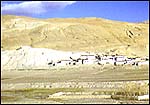


|
|
 |
| HOME | TRAVEL | TRAVELOG | ||

Behind the Bamboo Curtain ... to Lhasa, Tibet
Text and photographs: Nilesh Korgaonkar
Whilst in Nepal, the road is narrow and bumpy and traverses mountainous terrain and crosses numerous rivers. And five hours later we are at the rather grimy border crossing. A quick completion of formalities and you are loaded into the back of a small truck along with your baggage. A bone rattling 45 minute drive up the steep road and Zhangmu arrives. Time to be greeted by the Chinese customs.
The rarefied atmosphere, the lack of pollution and the high altitude produce some brilliant clouds against a deep blue sky, the likes of which are rarely seen over our cities. The road crosses some high passes at about 5200 m from where you get breathtaking panoramas of the Everest region on a clear day. Quaint Tibetan villages dot both sides of the road all along the way.
That us lesser mortals can also now follow in the footsteps of these high achievers is a fact that is little known except to daring backpackers. Automobile and aviation technology and the road building capability of the Chinese now makes the journey into Tibet possible for even the less adventurous.
And hence here I was on this minibus bound for Lhasa with an odd band of travellers for company. Three days of gruelling, yet fascinating travel got me to Shigatse, the capital of the Tsang region and seat of the Panchen Lama. It also has the largest functioning monastic institution in contemporary Tibet -- the fascinating Tashilhunpo Monastery. The Chinese occupation of Tibet is very apparent in these bigger cities though it does manifest itself even in the smaller towns that your cross. Shigatse is overtly divided into the more modern Chinese half and the definitely more ethnic Tibetan half. The Tashilhunpo Monastery is an impressive place and I could have spent days simply exploring the various temples with their intriguing golden roofs and imposing chortens that are really tombstones of yesteryear high lamas. The kora around the 26 m high statue of the Maitreya or the future Buddha is a soul stirring experience. Unfortunately it is housed inside a very sacred temple and no photography is permitted.
A relatively sedate 90 km drive from Shigatse brings you to the smaller town of Gyantse. In the early part of this century Gyantse was laid siege to by a British expeditionary force. The centre of all the excitement of that time, the Gyantse fort, is what catches the eye as you enter the town from the Chinese quarter. It soars into the azure skies from a craggy hill top and if time had permitted I would have definitely liked to climb up there and explored its precincts.
The drive on the fifth day to Lhasa takes you past the Yamdrak Tso, a turquoise lake, as its name indicates, of incredible resplendence. I donít think I will ever forget the stretch of road as it winds past the serene waters of the lake. The sky was overcast with dark clouds, it was late afternoon and the rays of the setting sun pierced through onto freshly fallen snow on the slopes of a hill on the opposite shores.
|
|
| Lhasa | |
|
|
|
|
HOME |
NEWS |
BUSINESS |
CRICKET |
MOVIES |
CHAT
INFOTECH | TRAVEL | LIFE/STYLE | FREEDOM | FEEDBACK |
|